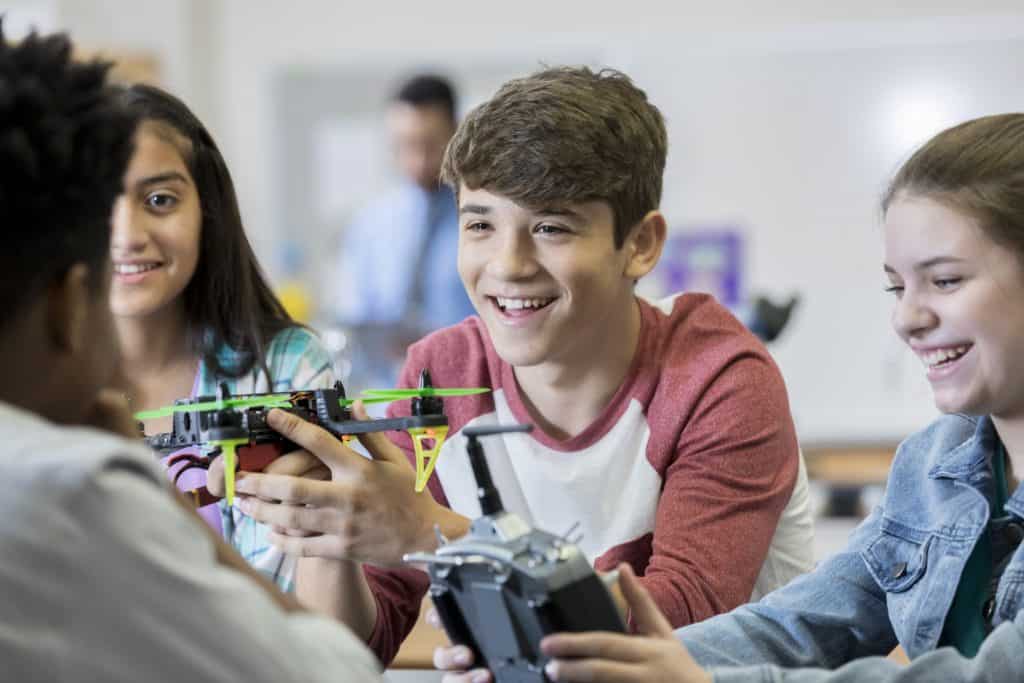Discovery of Unmanned Aviation (drones)! (Grades 3-5)

$399.00
Young learners answer the questions “What is the history of Unmanned Aviation?” and “How do they work?” Students learn how to program drone flight through coding in the Droneblocks application.
Course Description
Young learners answer the questions “What is the history of Unmanned Aviation?” and “How do they work?” Students learn how to program drone flight through coding in the Droneblocks application.
Level One
- Students will be able to explain what a drone is, its functions, and how it flies.
- Students will be able to launch a basic field mission including coding the drone flight and executing the three basic motions of a drone.
- Students will be able to operate a drone safely.
- Students will be able to build tools to measure key factors for safe drone operation.
- Students will be able to identify components of Scratch programming language.
- Students will be able to construct and follow a set of sequential instructions.
- Students will be able to compare the efficiency of sequences and loops in Scratch coding.
- Students will be able to fly a drone to simulate the task of searching for an object in an area.
Level Two
- Students will be able to simulate a real world flight by coding a flight pattern to scale.
- Students will be able to convert metric units for flight into imperial units.
- Students will be able to use block coding to program a drone to yaw in precise angles.
- Students will be able to use block coding to fly a precise course.
- Students will be able to code a drone to follow the perimeter of a complex figure.
- Students will be able to define a real world area to be explored in abstract.
- Students will be able to create a variable change.
- Students will be able to program a flight plan for multiple deliveries.
- Students will be able to test the range of the drone in 3 dimensions and record data about the effective range of the drone.
- Students will be able to plot, in abstraction a flight pattern, that takes range and battery into account.
Examples of Some Standards Addressed
NGSS
Crosscutting Concepts
Influence of Science, Engineering, and Technology on Society and the Natural World:
3-5-ETS1-3 Plan and carry out fair tests in which variables are controlled and failure points are considered to identify aspects of a model or prototype that can be improved.
Disciplinary Core Ideas
ETS1.C: Optimizing the Design Solution Different solutions need to be tested in order to determine which of them best solves the problem, given the criteria and the constraints.
CCSS
Math
MP.2 Reason abstractly and quantitatively.
MP.5 Use appropriate tools strategically.
Schedule
| Program | Date | Time |
|---|---|---|
| Drones: 3-5 Week 1 | Friday, February 3rd, 2023 | 6:00 pm -7:30 pm |
| Drones: 3-5 Week 2 | Friday, February 10th, 2023 | 6:00 pm -7:30 pm |
| Drones: 3-5 Week 3 | Friday, February 17th, 2023 | 6:00 pm -7:30 pm |
| Drones: 3-5 Week 4 | Friday, March 3rd, 2023 | 6:00 pm -7:30 pm |
| Drones: 3-5 Week 5 | Friday, March 10th, 2023 | 6:00 pm -7:30 pm |
| Drones: 3-5 Week 6 | Friday, March 17th, 2023 | 6:00 pm -7:30 pm |